?正则表达式在 Python 和 JavaScript 中都是一种强大的工具,用于匹配、搜索和操作字符串。尽管它们在基本语法上相似,但也存在一些差异。以下是 Python 和 JavaScript 在正则表达式的构造和使用上的主要比较:

1 正则表达式的构造和使用
特性 | Python | JavaScript |
导入库 | 使用 re 模块 | 无需导入,直接内置 |
定义正则表达式 | re.compile(r"pattern") | /pattern/flags 或 new RegExp("pattern", "flags") |
匹配全部 | re.findall(pattern, string) | string.match(/pattern/g) 或 string.matchAll(/pattern/g) |
搜索(找到第一个匹配项) | re.search(pattern, string) | string.match(/pattern/) 或 string.search(/pattern/) |
替换 | re.sub(pattern, repl, string) | string.replace(/pattern/g, repl) |
分割字符串 | re.split(pattern, string) | string.split(/pattern/) |
忽略大小写标志 | re.IGNORECASE 或 'i' | 'i' |
多行匹配标志 | re.MULTILINE 或 'm' | 'm' |
点号匹配任意字符(包括换行符) | re.DOTALL 或 's' | 无直接等价,可使用[^]来匹配任意字符包括换行 |
Unicode匹配 | re.UNICODE 或 'u' | 使用'u'标志 |
下面分别用 Python 和 JavaScript 的示例代码展示正则表达式的常用操作,包括匹配、搜索、分割、替换、量词、正向声明、反向声明、表达式分组和子表达式引用
import re
text = "The quick brown fox jumps over the lazy dog 123. Windows 2000 and XP Windows. test test."
# 匹配
match = re.search(r'\bfox\b', text)
if match:
print("Match found:", match.group()) # 输出 'fox'
# 搜索(使用量词和表达式分组)
search_result = re.findall(r'(\b\w{4}\b)', text)
print("Search results:", search_result) # 输出 ['quick', 'jumps', 'over', 'lazy']
# 分割
split_result = re.split(r'\s', text)
print("Split results:", split_result)
# 替换(使用子表达式引用)
replace_result = re.sub(r'(\w+) (\w+)', r'\2 \1', text)
print("Replace results:", replace_result)
# 正向和反向声明(Lookahead and Lookbehind)
lookahead = re.search(r'Windows(?= 2000)', text)
if lookahead:
print("Lookahead found:", lookahead.group()) # 输出 'Windows'
lookbehind = re.search(r'(?<=XP )Windows', text)
if lookbehind:
print("Lookbehind found:", lookbehind.group()) # 输出 'Windows'
# 子表达式引用
repeat_word = re.search(r'(\b\w+\b) \1', text)
if repeat_word:
print("Repeat word found:", repeat_word.group()) # 输出 'test test'
# 表达式分组使用
grouped = re.search(r'(\b\w+\b) over the (\b\w+\b)', text)
if grouped:
print("Words over:", grouped.groups()) # 输出 ('jumps', 'lazy')
let text = "The quick brown fox jumps over the lazy dog 123. Windows 2000 and XP Windows. test test.";
// 匹配
let match = text.match(/fox/);
if (match) {
console.log("Match found:", match[0]); // 输出 'fox'
}
// 搜索(使用量词和表达式分组)
let searchResult = text.match(/\b\w{4}\b/g);
console.log("Search results:", searchResult); // 输出 ['quick', 'jumps', 'over', 'lazy']
// 分割
let splitResult = text.split(/\s/);
console.log("Split results:", splitResult);
// 替换(使用子表达式引用)
let replaceResult = text.replace(/(\w+) (\w+)/g, '$2 $1');
console.log("Replace results:", replaceResult);
// 正向和反向声明(Lookahead and Lookbehind)
let lookahead = text.match(/Windows(?= 2000)/);
if (lookahead) {
console.log("Lookahead found:", lookahead[0]); // 输出 'Windows'
}
let lookbehind = text.match(/(?<=XP )Windows/);
if (lookbehind) {
console.log("Lookbehind found:", lookbehind[0]); // 输出 'Windows'
// 子表达式引用
let repeatWord = text.match(/(\b\w+\b) \1/);
if (repeatWord) {
console.log("Repeat word found:", repeatWord[0]); // 输出 'test test'
}
// 表达式分组使用
let grouped = text.match(/(\b\w+\b) over the (\b\w+\b)/);
if (grouped) {
console.log("Words over:", grouped[1], grouped[2]); // 输出 'jumps', 'lazy'
}
2 正则表达式的实例方法(仅JavaScript有)
2.1. exec()
- 描述: 执行对字符串的搜索匹配,并返回一个结果数组或 null。如果正则表达式包含了全局标志 (g),每次调用 exec() 将从正则表达式的 lastIndex 属性指定的位置开始搜索下一个匹配。
- 返回值: 返回一个数组,其中第 0 个元素是匹配的完整字符串,后续元素是匹配的捕获组(如果有)。如果没有找到匹配,则返回 null。
- 示例:
const regex = /(\w+)\s/g;
const text = "hello world";
let match;
while ((match = regex.exec(text)) !== null) {
console.log(`Found ${match[0]}, next starts at ${regex.lastIndex}.`);
// 输出: Found hello , next starts at 6
// Found world, next starts at 11
}
2.2. test()
- 描述: 测试字符串是否匹配正则表达式的模式。
- 返回值: 如果找到匹配则返回 true,否则返回 false。
- 示例:
const regex = /hello/;
const text = "hello world";
const result = regex.test(text); // 返回 true
console.log(result);
2.3. compile()
- 描述: 重新编译正则表达式。建议避免使用它,直接创建新的正则表达式实例更为合适和安全。
3 正则表达式的属性(仅JavaScript有)
3.1 实例属性
实例属性是绑定到正则表达式实例上的属性。它们提供有关特定正则表达式对象的信息,每个实例的这些属性都是独立的。常见的实例属性包括:
- source:
- 描述:正则表达式的源文本字符串。
- 用途:允许查看创建正则表达式时使用的确切模式。
- flags:
- 描述:标明正则表达式使用的修饰符(如 g, i, m 等)。
- 用途:快速查看正则表达式对象应用的全局规则和配置。
- lastIndex:
- 描述:下一次匹配开始的字符位置,仅在正则表达式使用全局标志 g 或粘连标志 y 时有效。
- 用途:在进行多次匹配时,控制或查询下次匹配的起始位置。
- global, ignoreCase, multiline, dotAll, unicode, sticky:
- 描述:这些布尔值属性反映了相应的修饰符是否被应用于正则表达式。
- 用途:提供对正则表达式行为详细了解的快速方式。
// 定义一个正则表达式对象,包含多个修饰符
let regex = new RegExp('foo', 'gim');
// 实例属性
console.log("Source:", regex.source); // 输出: foo
console.log("Flags:", regex.flags); // 输出: gim
console.log("Global:", regex.global); // 输出: true
console.log("Ignore Case:", regex.ignoreCase); // 输出: true
console.log("Multiline:", regex.multiline); // 输出: true
// 使用正则表达式进行匹配
let text = "Foo bar foo";
let match;
while ((match = regex.exec(text)) !== null) {
console.log(`Found '${match[0]}' at index ${match.index}`);
console.log("LastIndex after match:", regex.lastIndex); // 显示匹配后的 lastIndex
}
3.2 静态属性
静态属性与特定的 RegExp 对象无关,而是与 RegExp 构造函数本身关联。这些属性主要用于存储有关最近一次正则表达式操作的全局信息。静态属性的值会在正则表达式操作后更新,并且可以在不同的匹配和搜索操作之间共享。常见的静态属性包括:
- RegExp.input ($_):
- 描述:存储最近一次被匹配的完整字符串。
- 用途:可以快速查看或再次处理上一次匹配的字符串。
- RegExp.lastMatch ():
- 描述:存储最近一次成功匹配的整个字符串。
- 用途:用于引用上一次匹配的结果。
- RegExp.lastParen ($+):
- 描述:存储最近一次匹配的最后一个捕获组。
- 用途:在需要动态访问最后一个捕获组时非常有用。
- RegExp.leftContext (
python和JavaScript的正则表达式详细对比-今日头条 ``) 和 **RegExp.rightContext** (#39;`):- 描述:分别存储在最近一次匹配之前和之后的字符串部分。
- 用途:允许访问与匹配相关的上下文信息。
- RegExp.$1 到 RegExp.$9:
- 描述:存储最近一次匹配的第1到第9个捕获组。
- 用途:快速访问最近一次匹配中的特定捕获组。
let text = "Example text with 'term' and another 'term'."; let regex = /'term'/g; // 全局搜索 'term' // 进行匹配 regex.exec(text); regex.exec(text); // 静态属性 console.log("Last Match:", RegExp.lastMatch); // 输出: 'term' console.log("Last Paren:", RegExp.lastParen); // 输出: '', 没有捕获组 console.log("Left Context:", RegExp.leftContext); // 输出: Example text with 'term' and another console.log("Right Context:", RegExp.rightContext); // 输出: '. // 匹配多次后检查静态属性 console.log("Input:", RegExp.input); // 输出: Example text with 'term' and another 'term'.- ?编辑
?
猜你喜欢
- 2024-07-21 javascript简单的正则表达式应用「315」
- 2024-07-21 javascript 正则表达式校验密码格式
- 2024-07-21 学点JavaScript——正则表达式(三)
- 2024-07-21 JavaScript 正则表达式在表单中使用案例
- 2024-07-21 javascript之正则表达式(上)(js中正则表达式的用法)
- 2024-07-21 JavaScript 正则表达式基本语法(js正则表达式规则)
- 2024-07-21 学点JavaScript——正则表达式(四)
- 2024-07-21 学点JavaScript——正则表达式(五)
- 2024-07-21 关于Javascript正则表达式的一些学习笔记
- 2024-07-21 新的JavaScript功能将改变编写正则表达式的方式
